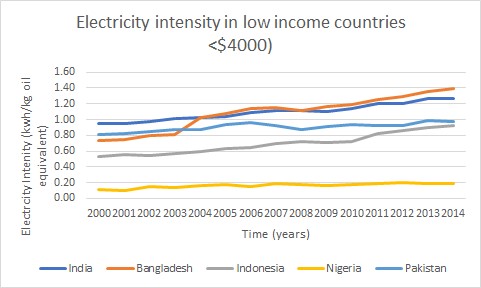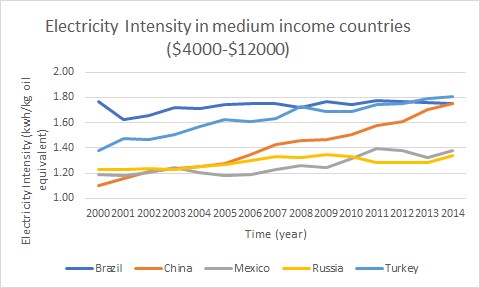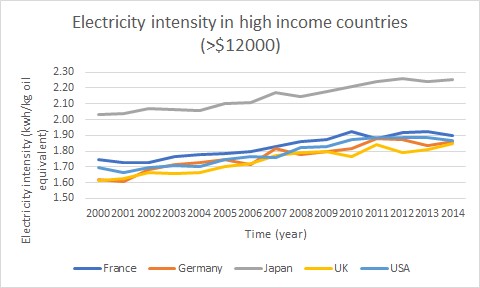My last series of blogs concentrated on Germany’s energy transition. Since the country’s reunification in 1990, there has been a major increase in electricity and decrease in primary energy use, which paralleled a similar growth in sustainable energy sources such as wind and solar (photovoltaic). Additionally, Germany decided to stop using nuclear energy following the Fukushima nuclear disaster in 2011. More recently, the country also decided to stop the use of coal. All these steps are contributing to a major reduction in Germany’s carbon footprint. As always, there are winners and losers in this transition. As we have seen in France, if the losers are not compensated, they may cause trouble (see my blogs on the Gilets Jaunes).
This week I will start to expand this kind of analysis globally.
There are 193 sovereign countries in the world that are members of the United Nations, as well as two observer states (the Holy See and Palestine). These include countries of all sizes and economic statuses. Some choose their governments through general election processes; others are ruled by autocratic leaders. To make analysis feasible I will focus this series on 15 countries, divided into three groups based on the World Bank’s low-, median-, and high-income classifications. In each group, I have selected the five most populous countries. Together, these 15 countries constitute 75% of the world’s population.
When I discussed the German situation in previous blogs, I based the analysis on German reporting. My global analysis will use World Bank data, as I have done here repeatedly. The World Bank gets its data from individual countries, and then subjects them to intense scrutiny. This takes a long time. As a result, its data are often less up-to-date than the countries’ original reporting. Therefore, the latest data available for all 15 countries is from 2000-2014.
These are the important indicators in this study:
-
Electricity intensity = Electricity use/Primary energy
-
Coal intensity (part of the IPAT relation): Ratio of coal to full mix of primary energy sources
-
Renewal intensity: Ratio of renewable or sustainable sources in primary energy and in electricity production
-
Carbon production
-
Energy intensity = Ratio of energy/GDP
-
Carbon intensity = ratio of Carbon/GDP and ratio of Carbon/Primary energy
I have discussed some of these indicators in earlier blogs in somewhat different contexts and will surely return to them later. Other indicators are new here.
Unfortunately, the data for most of these indicators are not directly available for these countries within the given time frame. I cannot just cut and paste them. I would have to calculate them directly from the World Bank database.
Let’s start with electric power consumption.
Here, I’m following the electricity intensity indicator, which is defined as the ratio of electricity use/primary energy use. I have discussed similar indicators here before, such as carbon intensity and energy intensity. When we associate an indicator with the word intensity, it can indicate different things. For instance, carbon intensity can be used in either the context of carbon dioxide emissions divided by GDP or those same emissions divided by energy use. I have previously taken a closer look at the version of carbon intensity that relates to GDP.
Electricity intensity can signify electricity use per employee, per GDP, per volume of data transmission, the ratio of retail electricity sales to commercial sector income or, probably the oldest definition, from physics:
“Electric intensity is the strength of electric field at a point. Electric intensity at a point is defined as the force experienced per unit positive charge at a point placed in the electric field”.
Going back to our definition of electricity intensity, it invokes electricity use per unit of primary energy use. Both functions in the definition are extensive and depend on population, so their ratio becomes an intensive function, independent of population. This means we can directly compare countries of different sizes.
Figures 1 – 3 show the changes in electricity intensity for the three groups of countries.
 Figure 1 – Low-income countries
Figure 1 – Low-income countries
 Figure 2 – Medium-income countries
Figure 2 – Medium-income countries
 Figure 3 – High-income countries
Figure 3 – High-income countries
The units in the three graphs are kwh/kg oil equivalent, which is standard in the World Bank database. Conversion to more common units will not change the trends.
In almost all cases we see consistent increase in the electricity intensity, matching the trends we saw in the blogs regarding Germany. Figure 3 shows Germany’s changes are roughly equivalent to those of the other large rich countries; Japan is the only outlier, with a higher baseline but a similar growth pattern.
We need to remember, however, that a consistent increase in electricity intensity does not necessarily mean a lower carbon footprint. In Germany, we saw that the increase in electricity intensity came with decreased use of primary energy and more sustainable energy sources such as wind and solar that replenish the electrical grid. While this is a positive incidence, it is not necessarily the norm. The most recent data from the World Bank show that access to electricity in low-income countries stands around 70% for urban settings and 28% for rural settings. Any wealth increase will be reflected in changes to electricity intensity and low-income countries tend to want low cost energy sources—for now, those are still fossil fuels. I will, of course, cover these issues in future blogs.

Although it is apparent that advanced nations use up quite a bit more energy than underdeveloped nations, it is agreeable that all nations across the board have increased their energy uses. the problem that I see in this is that these underdeveloped nations don’t really have a means to extract and utilize cleaner energy sources yet the so called developed nations that do have a means towards this goal make a poor attempt at doing so. A beginning step would be to have developed nations take charge in a clean energy revolution to thus trickle down these advances to underdeveloped nations.
I believe it is a smart idea for countries to switch to sustainable energy sources now rather than later. Climate change is only going to get worse as time goes on if we don’t take real action. It is good that Germany is taking a step in the right direction. As a world, we need to change our ways and do everything we can to decrease our carbon footprint.
I think its an interesting point when we talk about the fact that having a higher electric output does not necessarily mean becoming a greener country and reducing the carbon footprint. A lot of countries especially in the lower income bracet have huge mega cities and in general large populations, so the countries need to take every possible resource they have in order to supply their extensive populations. Making sure that rural areas have the access they need in order to modernize will prove to be a big challenge.
It really makes so much common sense that many low and high-income countries are increasing their electricity use throughout the years. This is due to the population shift from rural areas to urban areas in many of these countries.
In reading this post, I think about how technology typically becomes cheaper and more efficient the more widely-adopted it is. I can’t help but think how the world would look if more high and medium-income countries could prioritize a shift to cleaner energy. I imagine it’d lead to the technology developing enough that it could become more accessible to lower-income countries and redefine the current statistics presented here. One thing in the way of that seems to be competition. If fossil fuels get the job done cheaper and/or faster, it’s hard to get everybody on board, and even just one outlier here sort of messes it up for everybody. Then we’re back at square one. Ugh.
The use of technology required energy so the more we used it the more energy we took up. Therefore it is not a surprise when I saw how high income nations used up more energy since it is those nations that had many advanced technologies. Even though advanced technology improves the quality of life, it also harms us in many ways. Our health can be affected and the energy it requires to function is also harming the environment.
I think the information about Germany deciding to stop using nuclear energy and coal is important to take in since it’s decreasing their carbon footprint. I think they are taking good steps and I wonder if more countries can do actions similar to theirs to make a better impact on the world. More renewable sources need to be used and made like wind and solar energy power sources and less burning of fossil fuels. The graphs clearly show that their’s an increase in electricity usage for several countries so it makes sense if more renewable sources were made/used, electricity intensity will likely increase.
Great blog, interesting information. it’s Interesting to know that low income countries use around 70 percent of electricity for urban setting and 28 percent of electricity for rural setting.
An increase in the electricity intensity of course does not mean a lower carbon footprint, but it also doesn’t mean a higher carbon footprint as well. I hope countries are starting to use the electricity produced from renewable energy infrastructure to meet the increasing demand for electricity. This is hard because of the inconsistency of wind energy and solar, but I believe it is a step in the right direction to shift our energy reliance to renewable sources.
The graphs are very understandable. It displays higher-income countries use electricity more intense rather than low-income countries. That being said it would be smart to invest in more solar and wind power sources.
High, medium, and low income countries all displayed an increase in electric intensity throughout the past few years. However, it is clear that this is only beneficial when paired with a decrease in primary energy use. There is also a considerable gap between the high and low income countries in particular. It is important to make sure that this gap gets bridged, especially for the sake of sustainability. Furthermore, Germany is setting a great example for other countries by taking active steps to be more sustainable.
It’s great to see both developed and developing countries increasing their electricity usage though as you mentioned this is not necessarily accompanied by a decrease in fossil fuel usage. How can rural areas in developing countries economically adopt more solar and wind power sources to avoid less costly but more damaging fossil fuels and is the cost coming down or do they vary per region?
This is an informative post. I like how you simplify concepts, Professor Tomkiewicz. I see that there’s a trend in electricity intensity across different income levels. The fact that energy intensity is highest in high income nations is probably due to advanced technology that makes energy generation and harvest more efficient. You mentioned in the post that Germany is increasing its energy efficiency by employing more sustainable sources of energy. I know that the development of such technologies requires high startup costs, so I was wondering how we can have low income nations embark on a similar path when they’re mainly interested in low cost sources such as fossil fuels.